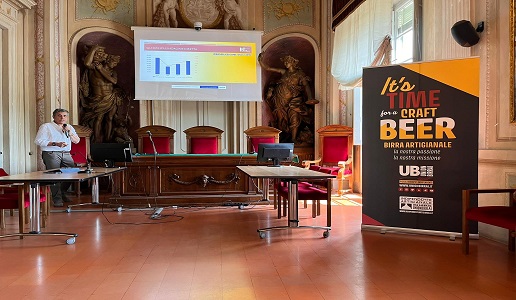Craft beer: +104% breweries in seven years and consumption on the rise

Unionbirrai presented data from the Report 2022 "Craft Beer, Supply Chain and Markets" edited by OBIArt, a detailed overview that analyzes the sector, delving into the numbers of craft beer, Italian brewing companies and consumption.
That of craft beer in Italy is a sector that continues to grow in terms of the number of breweries, which has not stopped even in the pandemic period, but also in terms of consumption. According to the CCIAA Business Registry, in 2022 the realities that produce beer in Italy reached 1,326 units employing a total of 9,612 direct employees, with a growth compared to 2015 of 104 percent in terms of breweries and 22 percent in terms of employees. This is highlighted in the Report 2022 "Craft Beer, Supply Chain and Markets" by Unionbirrai, the trade association of small independent breweries, produced by OBIArt, Laboratory of the Department of Agricultural, Food, Environmental and Forestry Science and Technology of the University of Florence dedicated to the study of the Italian craft brewing sector, which was presented in Florence today, Tuesday, June 27, 2023, by Professor Silvio Menghini, scientific coordinator of the Observatory, in the appointment that was also attended by Vittorio Ferraris and Francesco Mancini, general manager and Unionbirrai board member.
The report presents a detailed overview of the current health of the industry, in-depth look at the numbers of craft beer, Italian brewing companies and consumption, and highlights how Italy ranks sixth at the European level (after France, the United Kingdom, Germany, Switzerland and the Netherlands) in terms of number of breweries and ninth in terms of production volume with 17.6 mln hectoliters produced in 2021.
While geographically, breweries are now found to be widespread throughout the country (the largest number of companies in Northern Italy, but it is in the Central South that the largest increases continue to be recorded), the significant figure concerns the growth of agricultural breweries, which has in fact become an opportunity since 2010, when beer and malt production became part of the related activities practicable in primary sector companies. Present in just about eighty farms in 2015, by 2022 brewing will reach 290 agricultural enterprises, accounting for 22 percent of all national breweries and employing more than 1,000 people.
"Beer is growing in Italians' preferences, and craft beer is doing so even more. There may be several reasons for this, and a change in drinking culture is also among them. But it is important to give credit to the operators in the sector for all the work that is being done," stresses Vittorio Ferraris, general manager of Unionbirrai. "Increasing attention to raw materials, technological innovation, intelligent marketing and the ability to intercept consumer tastes are the main reasons why the craft beer sector is growing among the preferences of Italian beer consumers. The crisis brought about by the pandemic created great alarm not only because of the restrictions imposed by government anti-contagious initiatives that saw traditional trade channels shut down, but also because of the subsequent increase in raw material and utility costs caused by the end of the pandemic and the onset of serious geopolitical turmoil, which is still ongoing by the way. adds Ferraris - All factors that, as is evident, weigh much more heavily on the small and medium-sized companies that make up the productive fabric of Italian craft beer, making competition with large multinationals increasingly complicated and unequal. Yet, the reaction of our producers has been decisive and resolute, fighting to stay in the market by increasing the dose of creativity and innovation, to find solutions to the difficulties and continue to be a strong presence in the consumption of Italians. Practically a year after the end of restrictions, the sector has returned to previous levels, even surpassing them. This extraordinarily flexible and determined reaction is what allows me to be proud of our past and look forward to the coming years with confidence."
Restrictions introduced during the COVID period forced many companies to reorganize their distribution network, finding ways, after an initial lurch, to make up for the disadvantages. But resourcefulness, originality and creative power of master brewers represent important strengths for the industry, and this is demonstrated by a direct survey of craft breweries, which revealed that in the 130 companies surveyed, the total production realized in 2022 feeds 1,162 different labels permanently listed and 716 labels not permanently listed and associated with particular seasonal production or for other reasons not continuous: at the level of sample average, this means that each brewery has a portfolio with 7-10 different product lines. At the same time, the survey pointed out that craft breweries, in addition to the production and sale of beer, have articulated their occupation in a varied range of customer hospitality activities: in more than two-thirds of breweries customers, in addition to buying products, can also visit the facilities, in 46 percent of cases there is a tap room, while in 24.6 percent hospitality is organized in the terms of brew pubs and in 32 percent with food serving.
In terms of consumption and consumer behavior, the report indicates, based on a market survey of 1,700 contacts, 41 percent are regular beer consumers, 12 percent of industrial beer alone, and 29 percent of industrial and craft beer. "There is still much work to be done to improve the industry and to spread the consumption of craft beer. - concludes Ferraris - But we can take note that the sector is growing both in terms of the number of new companies and in terms of the spread of craft beer among consumers, although we must and can certainly do better in the specifics of the large-scale retail sector, where our kind of product struggles most to be handled with due attention to quality and durability. We have discovered how, within a greater interest in alcoholic beverages on the part of Italians, beer is growing much more than wine with consumption habits that are becoming less traditional and more varied, resembling more and more the Northern European model than the Mediterranean model more linked to wine and consumption during meals."
The full version of Report 2022 "Craft Beer, Supply Chain and Markets" will be on the www.unionbirrai.it.

 Italiano
Italiano







